Summary of November itinerary in Japan (Nagasaki / Fukuoka trip)
In Kyushu (Nagasaki and Fukuoka prefectures), where I traveled from November 15th to November 20th as best itinerary in Japan, I was able to eat a lot of seasonal fish and shellfish and local dishes as well as the trips in September and October, which was a very satisfying trip. I was also able to visit many wonderful tourist destinations such as World Heritage Sites and National Treasure Buildings. Here is a summary of this trip and some notes.
Table of contents
2. Seasonal “PRIDE FISH” by this itinerary in Japan
3. Travel precautions (local trains, buses, hotels) for itinerary in Japan
5. November 15 (Monday) Nagasaki Day 1
6. November 16 (Tuesday) Nagasaki Day 2
7. November 17 (Wednesday) Fukuoka Day 1
8. November 18 (Thursday) Fukuoka Day 2
9. November 19 (Friday) Fukuoka Day 3
10. November 20 (Saturday) Fukuoka Day 4
Following the itinerary in September and October, this itinerary was created with the purpose of “eating out seasonal fish and shellfish and local dishes.” Food is the highest priority, and tourist destinations are the second priority. However, we aimed to visit as many tourist spots as possible, such as World Heritage Sites, National Treasures, and Important Cultural Properties. September and October were quite busy itineraries, but this time I was traveling only in two prefectures, so I was able to travel on a relatively slow schedule. After all, I think that a trip to stay in about 2 prefectures is the best for a weekly schedule. It’s a good idea to travel slowly and with plenty of time, like my November itinerary.
1. “100 selections of local dishes” and “Local dishes loved by the nation” by this itinerary in Japan
Nagasaki: Sasebo Burger

Fukuoka: Game-ni, Karashi-mantaiko (spicy Alaska pollack roe)



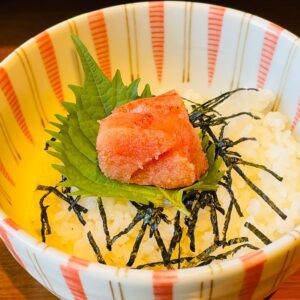


“100 selections of local dishes” and “Local dishes loved by the nation” are selected by the Ministry of Agriculture, Forestry and Fisheries.
I also visited Nagasaki Prefecture in March 2021. At that time, I ate “Shippoku ryori“, one of the 100 selections of local dishes, and “Champon“, one of Local dishes loved by the nation, so I will attach a photo of my visit in March just in case.


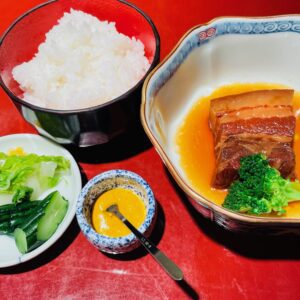

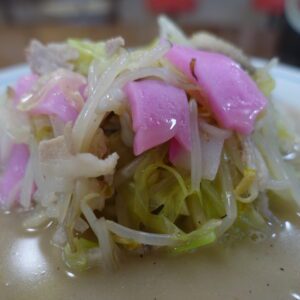

2. Seasonal “PRIDE FISH” by this itinerary in Japan
Fukuoka Prefecture:“Ippon-yari (fishing spear squid / swordtip squid, spear squid)” , “Kanato-fugu (Kanato blowfish)”






“PRIDE FISH” is selected by Japan Fisheries Cooperatives. “Ippon-yari (fishing spear squid / swordtip squid, spear squid)” is in season from April to November, “Kanato-fugu (Kanato blowfish)” is in season from August to December. The season for Ippon-yari was near the end, so the squid that I ate once in Nagasaki and Fukuoka prefectures was oval squid. Oval squid is in season from late November to mid-April in Kyushu. It has a sticky sweetness and was the best.
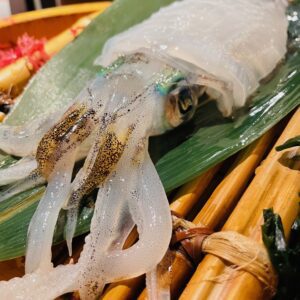


“PRIDE FISH” in Nagasaki Prefecture announced only four kinds of fish and shellfish a year, so I couldn’t eat it this time. Nagasaki Prefecture has a large variety of fish and shellfish and catches, so it may be difficult to narrow down to “PRIDE FISH”. All the fish and shellfish I ate in Nagasaki prefecture were the best.
3. Travel precautions (local trains, buses, hotels) for itinerary in Japan
I write the same thing every time, but it’s important, so I repeat it. This time as well, the rule of travel is an environment-friendly trip that uses only public transportation including rental bicycles.
Again, this is a reconfirmation, but traveling by public transport has far less CO2 emissions than traveling by car. For example, according to data from the Ministry of Land, Infrastructure, Transport and Tourism, CO2 emissions when one person travels 1 km are 130 g for automobiles, 98 g for aircraft (75% for automobiles), 57 g for buses (44% for automobiles), and 17 g for railways. 13%).
It was difficult to understand how to get on and off the one-man train this time as well. The one-man train of Matsuura Railway in Nagasaki Prefecture gets on from the back door and gets off from the front door. There was a poster on how to get on and off at Nishi-Tabira station, but it was only in Japanese. Since the number of trains running is small, some travelers may panic if they don’t know how to ride. Railroad operators and tourist associations should be responsible for providing guidance in foreign languages.
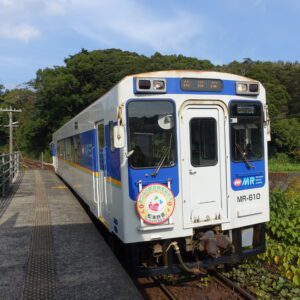

In the case of a one-man train, it is safe to always get on the first car. Be sure to remember the train boarding / alighting rules when traveling in rural areas of Japan. However, it depends on the railway operator whether you ride from the front door or the rear door of the first car.
This time, in Nagasaki prefecture, I was troubled by the small number of route buses and the distance from the bus stop of tourist spots. At Tabira Catholic Church, it was about a 20-minute walk one way from both the bus stop and the Matsuura Railway station. At Tabira Catholic Church, the parking lot for tourists has a large space, but there was no toilet for tourists. Also, the number of buses running to the observation deck of Kujukushima, which is the biggest highlight of sightseeing in Sasebo, was very small. Therefore, I had to walk for about 70 minutes (about 6km).
If the local government takes environmental issues seriously, I think that the tourism bureaus in each region should promote not only tourism by car but also tourism improvement by public transportation.
I often make mistakes, so I would like to make a note about hotel card keys and refrigerators. First of all, it is a hotel card keys, but if you do not insert this card, all the power in the room is turned off. If you try to charge an electronic device when you go out, it is not be charged if you remove the card. To solve this problem, you need to insert some card and go out.
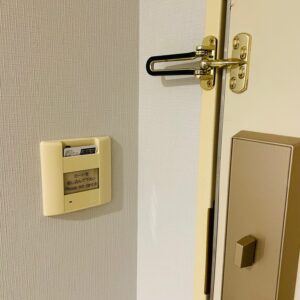

Also, depending on the hotel, the refrigerator may be turned off at check-in to save electricity. Please note that if you do not turn on the power, it is not cool even if you put beverages in the refrigerator.
Please see the detailed notes written on each travel day.
4. Travel in a light style
Again, I sent my clothes and power cord to my accommodation in advance for this trip, and enjoyed “luggage free trip” every day. After all, it is very easy to travel in a light style like taking a walk. Being able to act immediately after arriving by train or plane is important for effective use of time. Again, on the last day of the trip, I sent the clothes I wore during the trip to the laundry agent and did not have to do the laundry. I want everyone to experience the comfort of “luggage free trip”.
The unreserved seats on the limited express train “Sonic” from Kashii Station to Kokura Station were quite crowded, and there were almost no vacant seats. One of the reasons for the full capacity is that large luggage could not be placed on the shelves above the limited express train, and many customers left it in the next seat. The upper shelf is small as shown in the picture below. I would like travelers to be aware that bringing large luggage to the train will cause trouble for others.
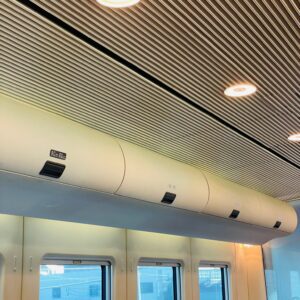

5. November 15 (Monday) Nagasaki Day 1
On the first day, I went sightseeing around Takashima and Sofukuji Temple in Nagasaki Prefecture.
The purpose of sightseeing in Takashima is to visit the world heritage site, “Sites of Japan’s Meiji Industrial Revolution: Iron and Steel, Shipbuilding and Coal Mining”.
Takashima’s World Heritage Site is the “Hokkeii mine site,” which is the first modern vertical shaft in Japan to introduce a steam engine.
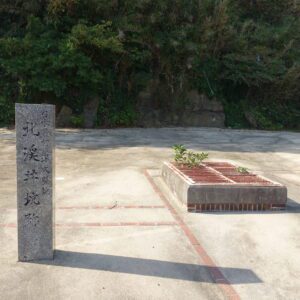

The biggest attraction of sightseeing in Takashima is that Hashima (Gunkanjima) looks beautiful. Hashima Coal Mine, along with Takashima Coal Mine, is one of the constituent assets of the World Heritage Site. Hashima is called “Gunkanjima” and is visited by many tourists.
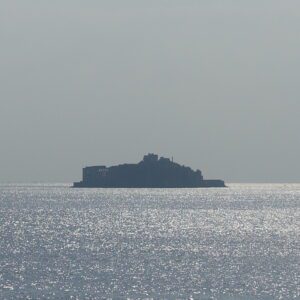

I was able to take a leisurely look at Gunkanjima in the absence of anyone. It was a luxurious time to feel like I was monopolizing Gunkanjima. I couldn’t see it because I left Takashima early, but I thought that Gunkanjima with the sunset in the background might look very beautiful.
I went to Sofukuji Temple last time, but I couldn’t forget its splendor, so I visited again this time. Sofukuji Temple was founded in 1629 by a Tang monk, Chonen who was invited by overseas Chinese from Fujian Province who was trading in Nagasaki. It is the oldest Chinese-style temple in Japan. It is now a temple of the Obaku sect, which is a Zen sect.


The Daiipomon and the Daiyuhoden are national treasures. The only national treasure buildings in Nagasaki Prefecture are Sofukuji Temple and Oura Catholic Church. In addition, there are five national important cultural properties (including four buildings) at Sofukuji Temple.
The Daiipomon of the national treasure is the gate on the stairs. The structure under the eaves of the gate is complicatedly assembled, and the colors are also very nice.
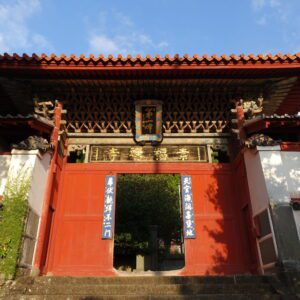



The Daiyuhoden is the national treasure and is a Buddhist temple whose principal image is Shaka. It is the oldest existing building in Nagasaki City. The roof that spreads wide to the side is wonderful. The principal image, Shaka, also has a really nice face.


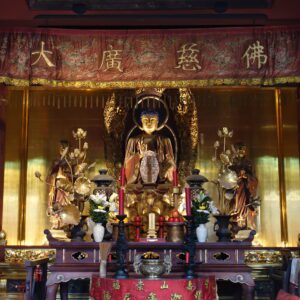

National important cultural properties are Sanmon (Romon), Gohodo (Kantei-do and Kannon-do), Maso-mon, and Bell Drum Tower. All are wonderful buildings.






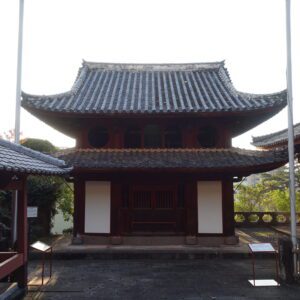

Meals
After visiting Sofukuji Temple, I had a dinner at “Yossou”. “Yossou” was opened in 1866 by the founder, Muneyoshi Yoshida, under the name of Yossou, as a restaurant specializing in chawan-mushi (a custard-like egg and vegetable dish steamed in a cup) and steamed sushi. It is a historic restaurant that was founded two years before the Meiji Restoration (1868).
The current building is a historic building built in 1927 (Showa 2). It was extensively renovated in 2012, and while the exterior of the building retains its atmosphere, the interior is a cozy Japanese space.
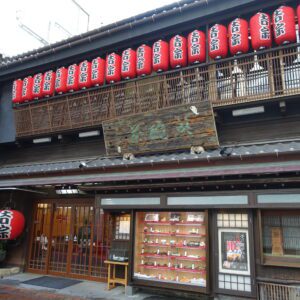

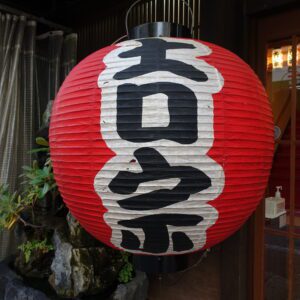

I had “Yossou set meal” (Yen 2,420). A set meal with traditional Yossou chawan-mushi, steamed sushi, and pork kakuni (Touba-Stew, which is also included in the shippoku ryori) and small bowls (boiled sharkfin, kinpira-style sauteed burdock, pickled turnip, and orange).
I thought it was a wonderful restaurant that can offer traditional tastes even in modern times. Staff of the restaurant was also friendly and the service was excellent.
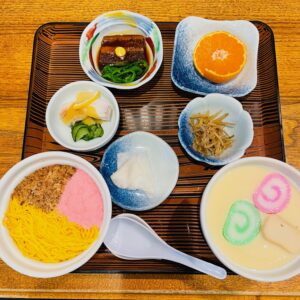

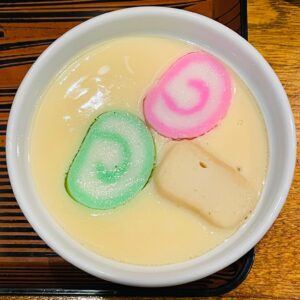

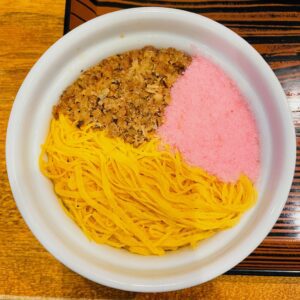

I didn’t eat fish and shellfish, which is the main purpose of this trip, so I went to the izakaya “Tarafuku Asa” after “Yossou”.
At “Tarafuku Asa”, I had assorted sashimi (flounder, live mackerel, amberjack, bonito, marlin, octopus, squid, scallop, ark shell), live mackerel sashimi, ginkgo nuts, and “kin-fugu” shiso tempura. The sashimi platter was from 2 people, but they also made it for 1 person. Nagasaki’s seafood, which has the second largest coastline in Japan and has a large catch, was really delicious.
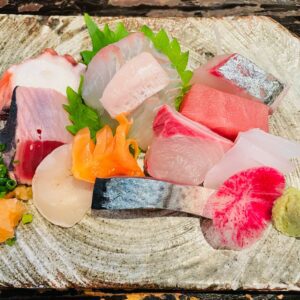

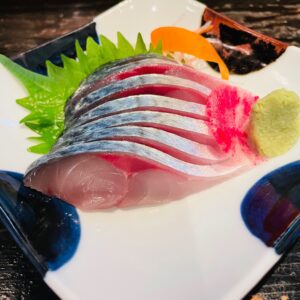

“Kin-fugu” is half-smooth golden pufferfish. It was branded as “Miyazaki Kin-fugu” in Miyazaki Prefecture. “Kin-fugu” I ate on that day was from Tsushima, but I think they wrote “Kin-fugu” on the menu because of the brand “Kin-fugu” in Miyazaki prefecture. In Fukuoka Prefecture, it is called “Kanato-fugu” (season is from August to December), and Japan Fisheries Cooperatives has selected it as the autumn “PRIDE FISH” in Fukuoka Prefecture.
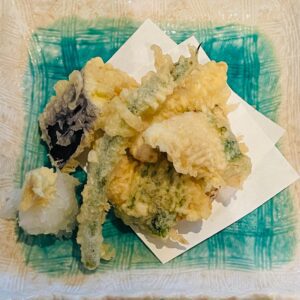

Important points
JR Nagasaki Station is undergoing a large-scale renovation. Due to the construction work, the sidewalks will be detoured, which is inconvenient. It is scheduled to be completed in the fall of 2023 in line with the opening of the Shinkansen.
It’s a small story, but the price of a coin-operated locker at Nagasaki Station is as high as Yen 600. The lowest price of a coin-operated locker is Yen 600, which is the highest price in Japan among all the trips I have made. The coin-operated locker price is Yen 400 at the Amu Plaza (shopping center) around Nagasaki Station, and Yen 300 at the Nagasaki Port Terminal and Nagasaki Prefectural Bus Nagasaki Terminal. If you are not particular about the coin-operated lockers at Nagasaki Station, it would be wise to leave them outside of Nagasaki Station.
6. November 16 (Tuesday) Nagasaki Day 2
I went to Hirado City in the early morning of the second day of my trip.It takes about an hour and a half to travel from Sasebo City to Hirado City.
Hirado Castle was the residence of Mr. Matsuura of the Hirado Domain. It has been selected as one of the 100 Castles of Japan.
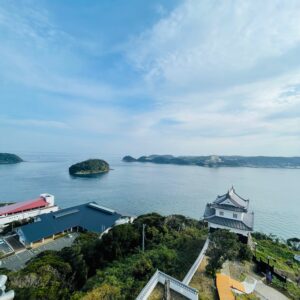

The current Hirado Castle is made of reinforced concrete, which was restored in 1962, so it is not designated as a cultural property. However, it was just reopened after a large-scale renovation in April this year, and the exterior and interior are very beautiful.




The biggest attraction of Hirado Castle is probably the view from the castle tower. You can see the intricate coastline, Hirado Dutch Trading Post, Hirado Ohashi and so on.
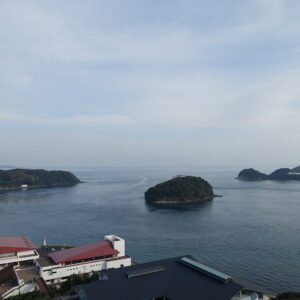

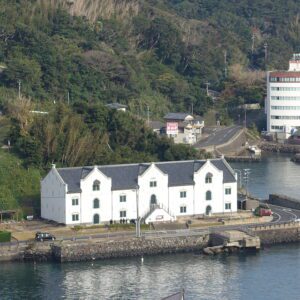



The current Hirado Dutch Trading Post has been restored. Although it was a short period of 33 years, Hirado was allowed to trade by the Edo Shogunate until it was relocated to Dejima, Nagasaki in 1641. Before the Edo period, Portuguese merchant ships first arrived in 1550, and in the same year, Jesuit Francis Xavier also visited Hirado. As a good natural port, Hirado prospered as a trading hub for about 90 years.
I left Hirado Castle and went to Tabira Tenshodo.It takes about 20 minutes on foot from the Koteda bus stop to Tabira Catholic Church. Climbing a gentle hill to Tabira Catholic Church makes me very tired.
Tabira Catholic Church was built in 1918 (Taisho 7). Although it is not included in the world heritage ” Hidden Christian Sites in the Nagasaki Region”, it is a national important cultural property. It is a church with a wonderful brick exterior. However, we cannot tour the inside.
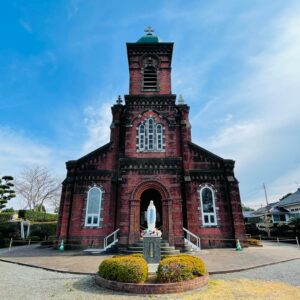



After getting off at Sasebo Chuo Station and having lunch, I went to Kujukushima, which is the centerpiece of Sasebo sightseeing.
Kujukushima bay is a scenic spot consisting of the intricately intricate ria coast and 208 large and small islands. It is called Kujukushima in the sense of “innumerable islands”. It was designated as Saikai National Park in 1955.
In 2018, Kujukushima Bay joined the “The club of the most beautiful bays of the world” as the fifth case in Japan. Others are Matsushima Bay (Miyagi Prefecture), Toyama Bay (Toyama Prefecture), Suruga Bay (Shizuoka Prefecture), Miyazu / Ine Bay (Kyoto Prefecture).
There are several observatories to see Kujukushima. I saw Kujukushima from “Tenkaiho” and “Ishidake”.
The Tenkaiho Observatory is located just off the bus stop at Tenkaiho.
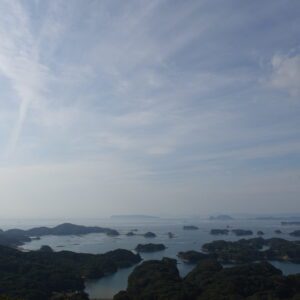

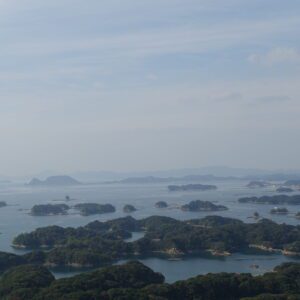

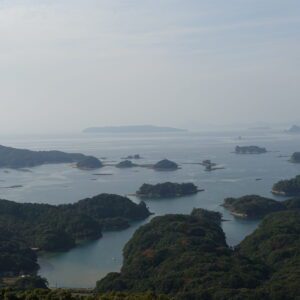

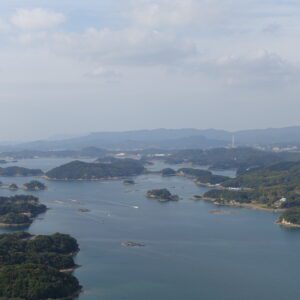



Next to Tenkaiho, I went to Ishidake Observatory by bus.
Ishidake Observatory is the place where the scenery of the islands that appears at the beginning of the movie “The Last Samurai” was shot. I was able to see the same beautiful scenery as the scenery from Tenkaiho.


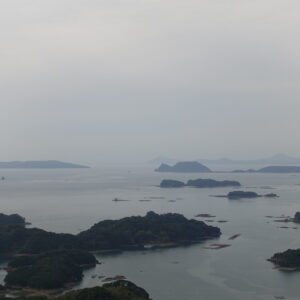



The opening scene of “The Last Samurai” is Kujukushima, which was dyed in the sunset color taken from Ishidake Observatory. I also thought about going to Ishidake Observatory in the evening, but it was forecast to be cloudy in the evening, so I went early.
Meals
I returned to Sasebo City from Hirado City and ate Sasebo Burger for lunch at “Big Man Kyomachi Main Store”. Sasebo Burger is a local gourmet that the Ministry of Agriculture, Forestry and Fisheries has selected as a “Local dishes loved by the nation” in Nagasaki Prefecture.
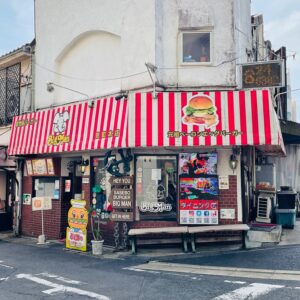

Sasebo Burger is said to have started around 1950 when restaurants in Sasebo heard recipes directly from the US Navy base and started making hamburgers around the US Navy base. According to the Japan Hamburger and Hamburger Association, Sasebo is Japan’s “The land of hamburgers”.
The “Big Man Kyomachi Main Store” I went to is a long-established hamburger store founded in 1970. Big Man was also the first to sell bacon and eggs burgers. “Big Man Kyomachi Main Store” is still highly evaluated, as it was selected as “100 Famous Stores in 2021” in the tabelog of the meal site and ranked first in the hamburger category in Nagasaki Prefecture.



At night, I had a dinner at the izakaya “Sasaizumi“. “Sasaizumi” is an izakaya with a fish tank inside. I entered the izakaya around 17:00, but it was full at 18:00. It can be said that it is one of the most popular izakaya in Sasebo city.
I ordered assorted sashimi (red sea bream, amberjack, “angel’s shrimp”), live squid, roasted mackerel using herb mackerel, surimi fried, fried oysters, and sushi using live horse mackerel.
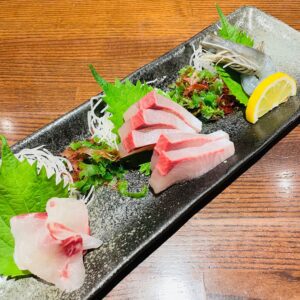

After eating live squid sashimi, the cook made tempura for free. The sashimi had a very strong sweetness of squid and was the best.




The roasted mackerel using herb mackerel was also very delicious. In Nagasaki Prefecture, mackerel grown by feeding a feed containing herbs is branded as “Nagasaki Herb Mackerel“.


What was more delicious than I had imagined was the “fried surimi” of fish. It had a fluffy texture and was delicious enough to eat as many as you like. It had a texture similar to Akashiyaki without octopus.


It was cold and it was the season for oysters, so the fried oyster was delicious. fried oyster is a classic winter food and is very delicious.
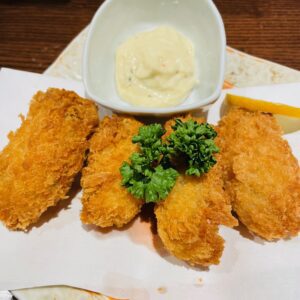

The last sushi I ate was delicious, but I was disappointed only by the late serving time. 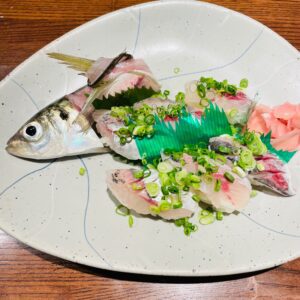

I left “Sasaizumi” and went to “Foreign Bar Street” for US soldiers. I wanted to drink at a store that is typical of Sasebo. Since Sasebo has a US military base, there is a restaurant for US soldiers. Of course, Japanese people can also enter the bar.
I went to the long-established “Gramophone” in “Foreign Bar Street” and talked with American soldiers while drinking whiskey. It was said that the US soldiers had not completely returned due to the influence of the COVID‑19, but there were 3-4 customers. The American soldiers were all friendly people and it was a fun night in Sasebo. Even though it is a bar for US soldiers, the staff is Japanese, so you can rest assured.
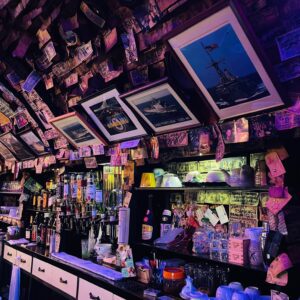

Important points
The problem with Tabira Catholic Church is that there is no toilet. To be precise, there is a toilet, but it can only be used by believers and not by visitors. Visitors have no choice but to rent a toilet at Tabira Insect & Nature Park, which is about a 10-minute walk from Tabira Catholic Church.
The return trip from Ishidake Observatory to Sasebo City was a problem. There is only one bus running every two hours, and I can’t return from the Ishidake Observatory. I couldn’t help it, so I decided to walk back to Sasebo Station. The distance was about 6km and it took about 70 minutes.
7. November 17 (Wednesday) Fukuoka Day 1
On the third day of my trip to Nagasaki and Fukuoka, I left Sasebo Station in the morning and headed for Zendoji temple in Kurume City, Fukuoka Prefecture.
Zendoji is a temple of the Jodoshu Daihonzan, which is said to have been opened by Shoko Shonin (Chinzei Shonin) in 1208. Shoko Shonin is a disciple of Honen Shonin, the founder of the Jodo sect. Shoko Shonin was from Chikuzen Province (now Kitakyushu City).
There are eight national important cultural properties, including the main hall, Daimon, and the back of the warehouse. Daimon was built in 1651 and is the oldest building in Zendoji.


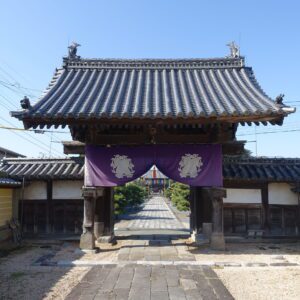

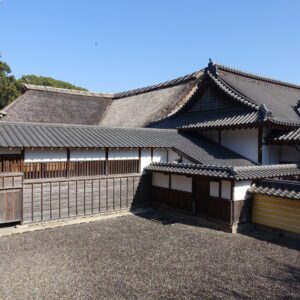

I left Zendoji and I went to the Arima family mausoleum (Tamaya), which is about a 5-minute walk from Kurume Station. The Arima family mausoleum is located in the precincts of Bairinji temple, the family temple of the Arima clan, the lord of the Kurume domain. Bairinji temple is an ancient temple of the Rinzai sect, which is a sect of Zen. The five Arima family mausoleums are national important cultural properties.


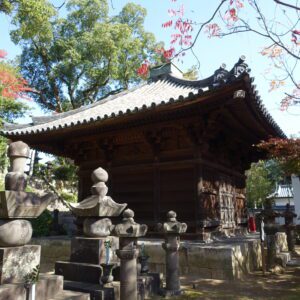

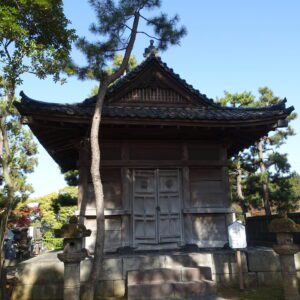

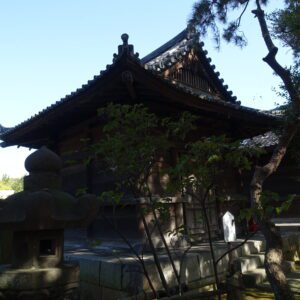



On the day I visited, the autumn leaves such as ginkgo were wonderful. There was only one family visiting the grave at Umerinji, and it was a quiet temple like Zen Buddhism. A walk in the precincts is recommended.
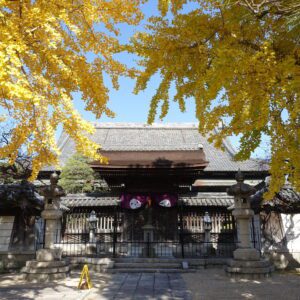

After having lunch in Kurume city, I headed to Dazaifu. After arriving at Dazaifu Station, I headed to Kamado Shrine.Kamado Shrine has a long history of more than 1350 years since its foundation. It has played the role of avoiding the influence of the demon of Dazaifu.


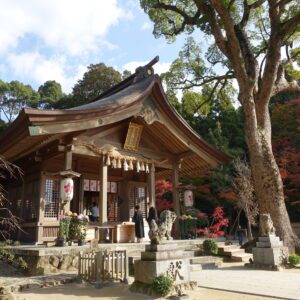

Kamado Shrine is the same as the name of Kamado Tanjiro in “Kimetsu no Yaiba”, and its role as avoiding the influence of the demon in Dazaifu is similar to the role as chasing the demons away of Kamado Tanjiro. It is said that it is the model shrine of “Kimetsu no Yaiba”, and the number of visitors is increasing. Also, the fact that the swordsman “Muso Gonnosuke” in the early Edo period is enshrined in the precincts of Kamado Shrine fit the image of “Kimetsu no Yaiba”. Although it was a weekday when I visited, the parking lot was full and there was a large queue waiting for the bus. Also, like Bairinji, the autumn leaves were beautiful.
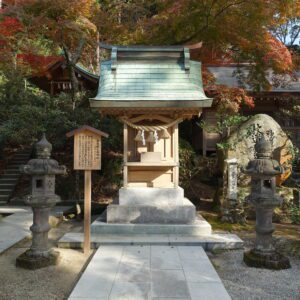



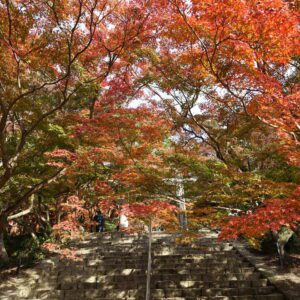



I walked to Dazaifu Tenmangu Shrine from Kamado Shrine. It takes about 20 minutes on foot, but it didn’t bother me so much because it was a downhill road.
Dazaifu Tenmangu Shrine is the main shrine of about 12,000 shirines nationwide that enshrines Sugawara no Michizane. The main shrine and Shiga shrine are national important cultural properties. Shiga shrine, which was rebuilt in 1458 during the Muromachi period, is older than the main shrine rebuilt by Takakage Kobayakawa in 1591 during the Azuchi-Momoyama period.
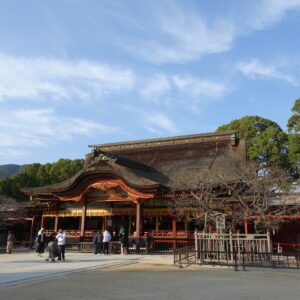

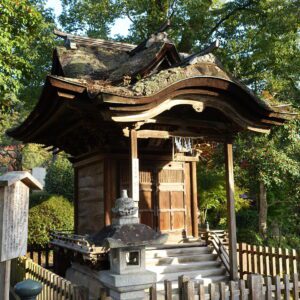

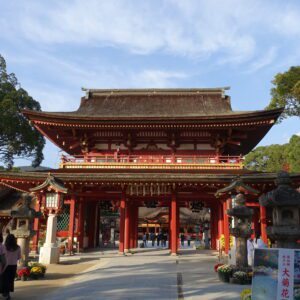

Meals
After visiting the Arima family Mausoleum, I had Kurume ramen at “Menshi“. I ordered a lunch set (Ramen Kokorozashi and Kurume Darum Don) at “Menshi”. It is difficult to explain the taste of the “Ramen Kokorozashi” I ate, but I was impressed by the surprising taste. It was delicious enough to be in the top 5 of the Tonkotsu (pork bone) ramen I had eaten in the past. The staffs of ramen shop were also cheerful and pleasant to serve customers. The store was always full.


I didn’t know until I went to Kurume, but Kurume is the birthplace of tonkotsu ramen. The first tonkotsu ramen was devised by Tokio Miyamoto, the first manager of the ramen shop “Nankin Senryo” in 1937, by fusing Champon in Nagasaki Prefecture, where he was born, with Chinese noodles in Yokohama. The difference is that Kurume ramen is a way to add soup when the soup is low, while Hakata ramen is a method of making just the amount of soup used that day. Kurume ramen is basically not fat, so it is relatively light.
Kurume Darum Don is a white offal bowl. The name “Darum” seems to have started when medical students called the intestine Darm (German) in medical terms.


At the “Furo Chaya (teahouse)” in Tenmangu, Dazaifu, I had a set of Umegae Mochi, a specialty of Dazaifu, and matcha (Yen 600 tax included).
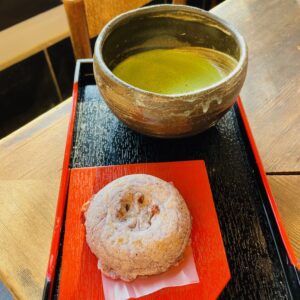

Umegae Mochi is said to have originated from the fact that when Sugawara no Michizane was under house arrest, an old woman inserted a mochi stabbed into the tip of a plum branch through the lattice in the room, but there are various theories.
For dinner, I had a motsunabe with a friend from college at “Miyamoto“, near Gion Station in Fukuoka City. It is a long-established popular store founded in 1974, which was also published in the 2019 Michelin Guidebook Fukuoka.
The characteristic of Miyamoto’s motsunabe is that they serve the first motsunabe with only beef offal and garlic. From the owner’s desire to simply taste the deliciousness of beef offal that has been prepared for 4 hours, a motsunabe of beef offal and garlic chives is provided. This simple motsunabe is delicious because of the owner’s commitment. Later, we added tofu and cabbage, but I felt that the simple motsunabe with beef offal and garlic was more delicious.
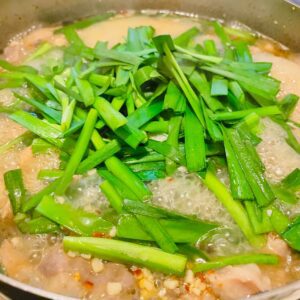

In addition, the motsunabe of “Miyamoto” has a strong soy sauce flavor that goes well with sake. We were drinking more and more and we drank more than usual.
Important points
You can also take a bus from Kamado Shrine to Dazaifu Tenmangu Shrine, but it is very crowded. The bus stop was a long line. It’s a 20-minute walk, and it’s easy because it’s downhill. However, it is better to take a bus as it is an uphill slope from Dazaifu Tenmangu Shrine to Kamado Shrine. In addition, I could get on the bus from Dazaifu station without lining up.
8. November 18 (Thursday) Fukuoka Day 2
On the morning of the 4th day, I went to Munakata Taisha “Hetsu-miya” from Hakata Station.
Munakata Taisha is one of the oldest shrines in Japan, which is also mentioned in “Nihon Shoki” and “Sequel Nihon Shoki”. It is the head shrine of more than 7,000 shrines in Japan that enshrine the Three Goddesses of Munakata, Itsukushima Shrine.
Munakata was the first international port in Japan. As a port to the Korean Peninsula and China, it played the role of diplomacy, commerce, and national defense in ancient Japan for about 500 years from the latter half of the 4th century to the end of the 9th century. For these reasons, in 2017, Munakata Taisha Shrine was registered as a World Heritage Site as “Sacred Island of Okinoshima and Associated Sites in the Munakata Region” .
In addition, the main shrine and worship hall of Munakata Taisha “Hetsu-miya” are designated as national important cultural properties. The main shrine was built in 1578 and the worship hall was built in 1590.


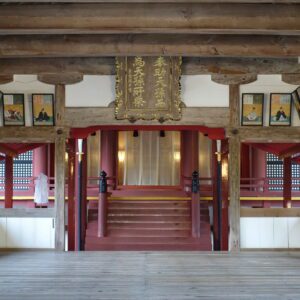

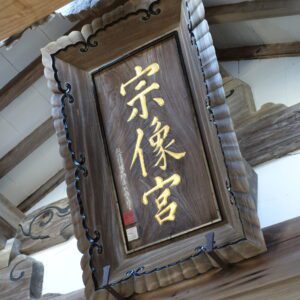

There are 22 small shrines around the main shrine, and 121 gods are enshrined. The existence of small shrines lined up in a row is a masterpiece and shows the high shrine rank of Munakata Taisha.
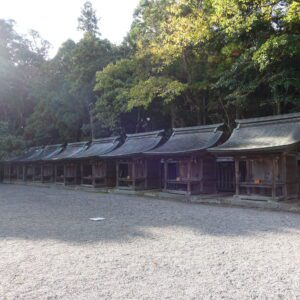

“Takamiya Saijo” is an ancient festival grounds that is said to be the land of descent of Ichikishima-hime God. There are only a few places in Japan where ancient festivals based on nature worship remain. It is considered to be one of the most sacred places in the precincts of Munakata Taisha.


At the time of my visit, there was no one else at the “Takamiya Saijo”. Therefore, I was able to enjoy the solemn atmosphere of the ancient festival grounds. The place I was most impressed with at Munakata Taisha was the “Takamiya Saijo”.


The Shinpokan of Munakata Taisha is a collection of 80,000 national treasures of Okinoshima God, as well as important cultural properties that have been handed down to Munakata Taisha. It was my first experience to see so many national treasures at once, and I was really overwhelmed.


Almost all of the items on display at the Shinpokan are national treasures of super-first-class academic and artistic value, and are exceptional treasure museums. By all means, I would like everyone to visit the Shinpokan.
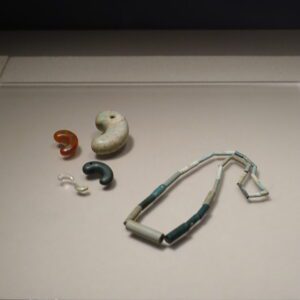

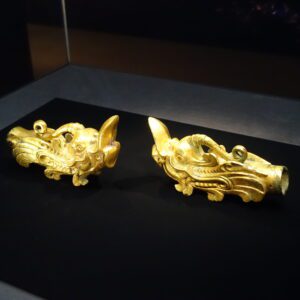

Admission fee: Yen 800 for adults, Yen 500 for high school / university students, Yen 400 for elementary / junior high school students
I took a bus from Munakata Taisha “Hetsu-miya” to Konominato Port and went to Oshima by ship.
After having lunch, I went to “Okitsu-miya Yohaisho” by bicycle. The “Okitsu-miya Yohaisho” was set up on the north side of Oshima to worship Okinoshima, which is prohibited from going to the island.
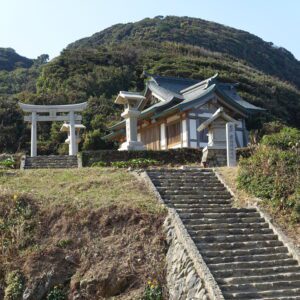



The weather was nice, so the sea around the “Okitsu-miya Yohaisho” was very beautiful.
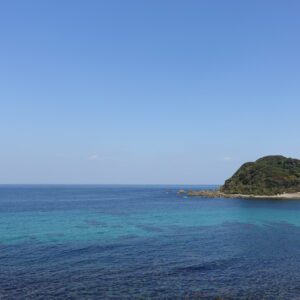

The main shrine of Nakatsu-miya was built in 1566. It is a very nice hall of worship and the main hall.
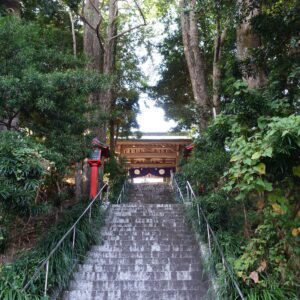

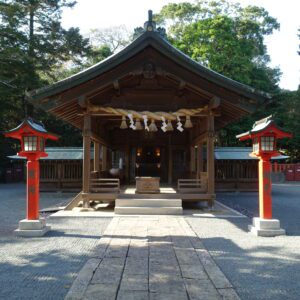

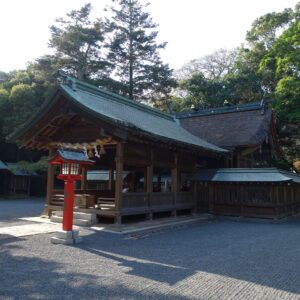

Munakata Shrine “Hetsu-miya” and Oshima were all wonderful, including buildings, ancient festival grounds, national treasures of the Shinpokan, and beautiful scenery of Oshima. By visiting Munakata City this time, I was able to discover the new charm of Fukuoka Prefecture.
Meals
Immediately after crossing Oshima by boat, I ate “Special Kaisendon (seafood bowl)” (Yen 2,200 including tax) at “Kotobukiya Saburo”. “Kotobukiya Saburo” is a restaurant run by a fisherman, and you can eat a lot of fresh seafood.


The “Special Kaisendon” I ate was also full of sashimi from the bowl. The fresh seafood was very delicious and it was a very satisfying lunch.
I returned to Hakata from Oshima and ate Tonkotsu (pork bone) ramen (Yen 680 including tax) at “Hakata Issou Hakata Station East Main Store”. “Hakata Issou Hakata Station East Main Store” is a popular ramen shop that has been selected as one of the 100 famous restaurants in 2021 by Tabelog.


“Hakata Issou” is a relatively new ramen shop founded in 2012. It was delicious to visit during my previous trip to Fukuoka, so I revisited this time. It may not look very delicious in the photo, but it was an excellent tonkotsu ramen. There is not arrogance even though popular stores, and the staff were cheerful and pleasant. It is understandable that it continues to be a prosperous ramen store.
I met up with a friend and ate gyoza (dumplings) at “Asahiken Kawabata store”. Fukuoka city is not well known as a dumpling town, but there are many dumpling shops in the city. In the 2020 household survey, Fukuoka City was the sixth largest dumpling consumption in Japan at the prefectural capital. The first place is Utsunomiya City, which is famous for dumplings.
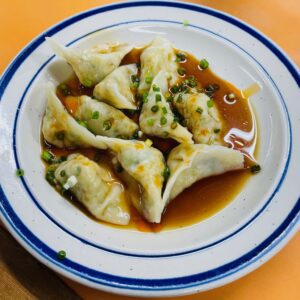



Many people asked for grilled gyoza, but I thought that boiled gyoza was better. I felt the smooth texture of the boiled gyoza was the best.
After leaving “Asahiken Kawabata store”, I entered “Dive Bar Hakata Katsuriki” on the way back to the hotel and had a light meal. Foods of “Katsuriki” is cheap and delicious, and I thought that even a chain izakaya is a izakaya with abilities.


Especially, the assorted torisashi (chicken sashimi) and the pickled chicken liver were excellent. Also, the tuna dumpling soup was offered at an unbelievable price of only Yen 5. It was a very delicious soup. In addition, the fact that it does not give out “Otoshi (appetizer)” is also highly favorable.
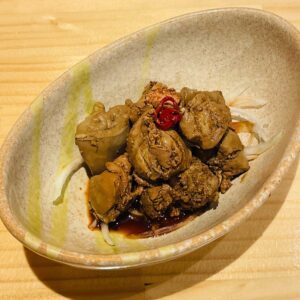



Important points
The bus stop at Konominato Port, where ships heading for Oshima depart, is Konominato hatoba (wharf). Please note that there are three bus stops with the name of Konominato (Konominato Iriguchi (entrance), Konominato basu-tei (bus stop), Konominato nishi-guchi (west exit) up to the Konominato hatoba (wharf).
I think it is worth trying “Meshidokoro Harunohi” for meals on Oshima. It is a restaurant that requires a reservation. When I called the reservation on the day, it was already full. “Kotobukiya Saburo” is a simple restaurant run by a fisherman. On the other hand, seeing the homepage of “Meshidokoro Harunohi” Although it says “Old-fashioned fisherman’s dining room”, it seems to be a decent Japanese restaurant. If I go to Oshima next time, I would like to make a reservation for “Meshidokoro Harunohi” in advance.
9. November 19 (Friday) Fukuoka Day 3
On the 5th day of my trip to Nagasaki and Fukuoka, I first went to Kashiigu in the morning.
The homepage of Kashiigu says that the origin of Kashiigu is that Empress Jingu built a shrine in 200 AD and worshiped the spirit of Emperor Chuai. The current main shrine was reconstructed in 1801 and is the only architectural style in Japan called “Kashii-zukuri”. The main shrine is a national important cultural property.




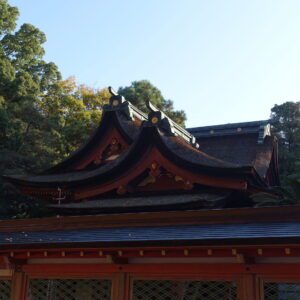

The tower gate is a magnificent gate that was rebuilt in 1903. The atmosphere felt like the gate of a Buddhist temple of Zen Buddhism.


I headed to Mojiko from Kashiigu. The station building of Mojiko Station is designated as a national important cultural property. This station and Tokyo Station Marunouchi station building are the only station buildings designated as national important cultural properties. The current Mojiko station building was completed in 1914. I think it’s a nice station building no matter how many times I see it.
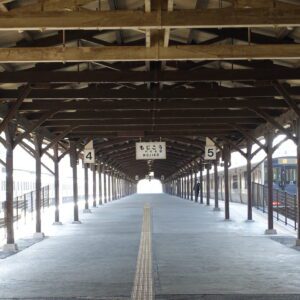

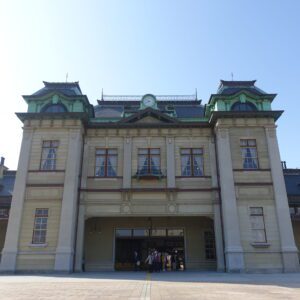

Each tourist attraction of Mojiko opened its grand opening in 1995 as “Mojiko Retro“. The distance between each sightseeing spot is short, and we can go sightseeing on foot.
The building in front of Mojiko Station is the “Moji Yusen Building”. It was built in 1927.
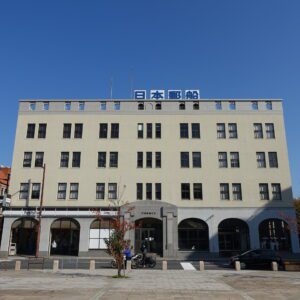

The building next to the Moji Yusen Building is the Old Moji Mitsui Club. It is a customer service facility built by Mitsui & Co., Ltd. Moji Branch in 1921. It is a national important cultural property.
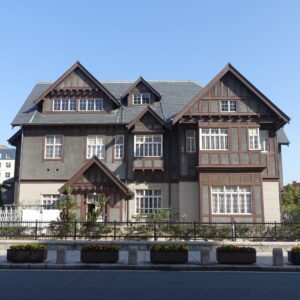

JR Kyushu Headquarters (formerly Mitsui & Co., Ltd. Moji Branch) was built in 1937 as Mitsui & Co.’s third generation Moji Branch. I prefer the side with stairs to the front.


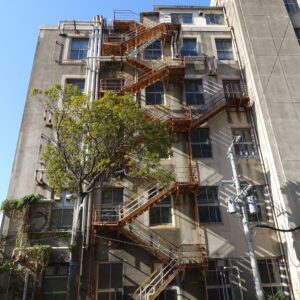

Old Moji Customs Building was built in 1912 as the second generation of the Moji Customs, which was destroyed by fire. 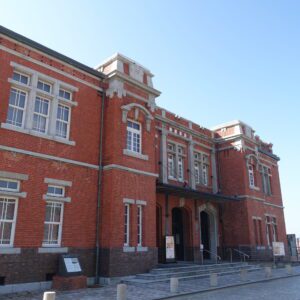

In 1979, Kitakyushu City and Dalian City formed a friendship city. The Dalian Friendship Memorial Hall was built by replicating the building of the railway steamship company built in Dalian in 1902 by the Russian Empire to commemorate the 15th anniversary of the signing of the Friendship City.


The Mojiko Retro Observation Room is located on the 31st floor of the high-rise condominium “Retro High Mart” designed by Kisho Kurokawa, one of Japan’s leading architects. The observation room is 103m high, and we can see the Kanmon Strait and Kanmon Bridge beautifully. The Kanmon Bridge is a suspension bridge with a length of 1,068 meters. The sea at the foot of the pier on the Shimonoseki side of the Kanmon Bridge was the stage of the Battle of Dannoura (1185) in the Genpei War.
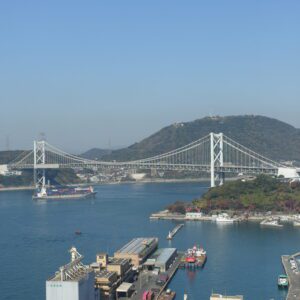



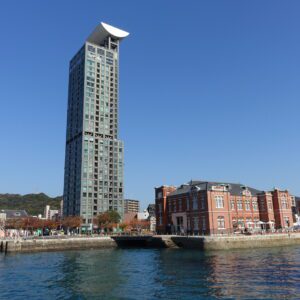

Admission: Adults Yen 300, elementary and junior high school students Yen 150
Old Mitsui O.S.K. Line Building was built in 1917 as the Moji branch of Osaka Shosen. It features an octagonal tower at the corner of the building. It is registered as a national tangible cultural property.
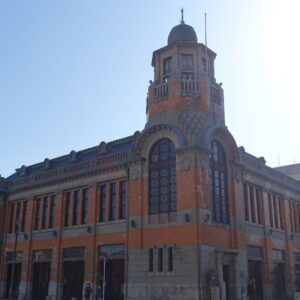

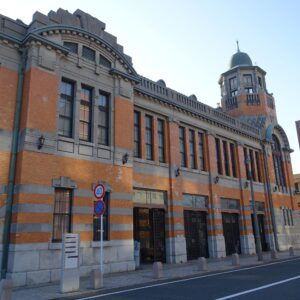

Holme Ringer & Co.Ltd. building was built in 1962. The predecessor company was the Holme Ringer & Co.Ltd., which was founded by British trader Frederick Ringer in 1868, the last year of the Edo period, together with Edward Zohrab Holme.
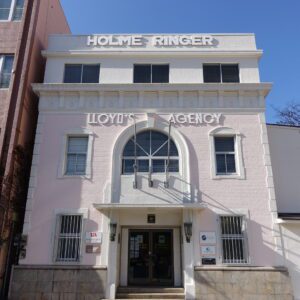

There is “Blue Wing Moji” in the immediate vicinity of Holme Ringer & Co.Ltd.. It is a drawbridge exclusively for pedestrians. It jumps up to a 60 degree angle once an hour. It is a pleasant place where you can see the Kanmon Bridge.


NTT Moji Telecommunication History Hall was built in 1924 as the Moji Post Office Telephone Division, Ministry of Communications.
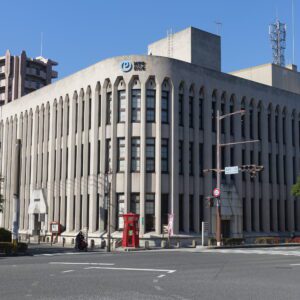

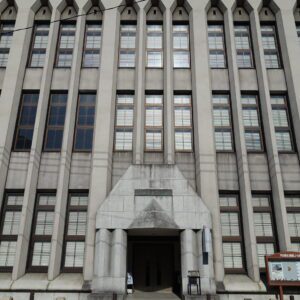

Sankiro is a three-story wooden former restaurant built in 1931. In the past, it prospered as one of the top three restaurants in Mojiko. Many celebrities such as Sazo Idemitsu, the founder of Idemitsu Kosan, and Kyoshi Takahama, a poet, visited.


You can visit the inside for free. I learned from the volunteers who gave me very polite explanations. I strongly recommend that you take a tour of the interior of Sankiro.
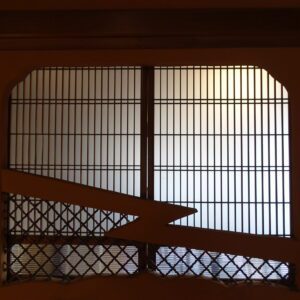



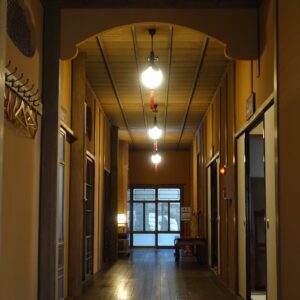



Meals
Immediately after arriving at Mojiko, I had the Kawara Soba Mentaiko Chazuke set (Yen 1,760 including tax) at the Originator Kawara Soba “Takase” on the 2nd floor of the Kaikyo Plaza West Building. Kawara soba is a local gourmet in Shimonoseki City, Yamaguchi Prefecture.
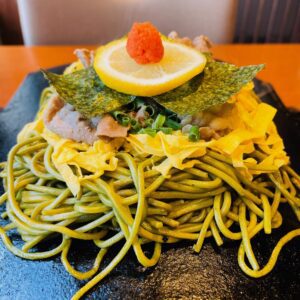

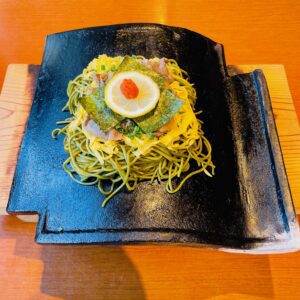

I had Kawara soba for the first time and it was delicious soba. I think it’s a fun soba that it’s difficult to eat without dropping the ingredients on the curved roof tiles, and eating itself becomes a kind of event.



The Mentaiko chazuke of the Kawara soba Mentaiko chazuke set I had is a genuine local gourmet in Fukuoka prefecture. The Ministry of Agriculture, Forestry and Fisheries has selected Karashi-mentaiko (spicy cod roe) as one of the “Local dishes loved by the nation” in Fukuoka Prefecture.
We can drink the craft beer “MOJIKO BEER” at the Mojiko Retro Observation Room. It was great to drink craft beer while looking at the Kanmon Strait. The “MOJIKO BEER” Weizen I drank won the highest award of the National Craft Beer Quality Examination Committee twice. It was a delicious beer.
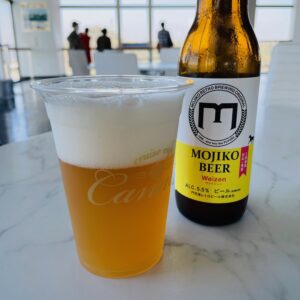

The ramen shop I found by chance while taking a walk in Mojiko Retro is “Daiheizan Mojikoko Store“.
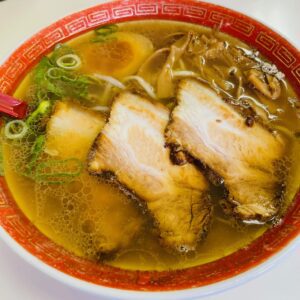

I ordered Daiheizan ramen (Yen 800 including tax). It was a ramen with soy sauce and tonkotsu (pork bones), and it was one of the top 5 in my life history. Maybe it was my best ramen in my life. The soup has a perfect balance of soy sauce and tonkotsu, and the pepper that was applied from the beginning really matched the soup. It was a delicious taste that was hard to express. Also, the noodles themselves were very delicious. It went well with the soup and it produced a synergistic effect. The roasted pork fillet, Ajitama (soft-boiled egg marinated in soy and mirin) , and menma (sungan) were also exquisitely seasoned.


After arriving at Hakata Station, I went to “Izakaya Hikari”, which is a 1-minute walk from the Chikushi Exit of Hakata Station. “Hikari” is a long-established popular izakaya that was full after 6 pm, and many people were refused entry.
I ordered blue mackerel, Sansaimori (three kinds of sashimi), squid sashimi, longtooth grouper sashimi, fried kanato-fugu (half-smooth golden pufferfish), and Game-ni.
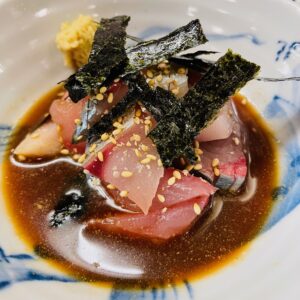

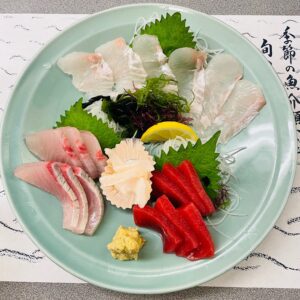




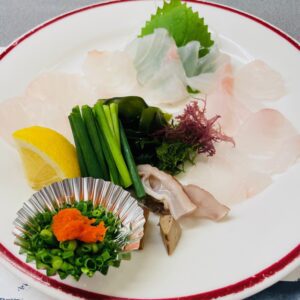




Squid (season: April-November) and Kanato-fugu (season: August-December) have been selected by the National Federation of Fisheries Cooperatives as “PRIDE FISH” in Fukuoka Prefecture. Kanatofugu is also called Shirosaba-fugu, as I introduced in the BLOG on December 10th. It has been loved by people in Fukuoka prefecture because it is more affordable than tiger puffer.



Game-ni is a local dish of Fukuoka prefecture, also known as “Chikuzen-ni”. It has been selected as one of the “100 Best Local Cuisine” by the Ministry of Agriculture, Forestry and Fisheries.
“Izakaya Hikari” is a popular restaurant, so most of the meals were delicious and I left the restaurant with great satisfaction. It is a recommended izakaya because it is conveniently located near Hakata Station.
Important points
I didn’t have any problems on this day.
Mojiko I visited on this day belongs to Kitakyushu City. Kitakyushu is the second most populous city in Fukuoka Prefecture and the 14th most populous city in Japan as a whole. As of 2020, Fukuoka City has the largest population of about 1.6 million, while Kitakyushu City has about 940,000. The center of Kitakyushu is Kokura Station. There are many highly rated restaurants such as sushi restaurants around Kokura Station, so it might be a good idea to eat around Kokura Station when you go to Mojiko.
10. November 20 (Saturday) Fukuoka Day 4
On the last day (6th day) of my trip to Nagasaki and Fukuoka, I visited shrines and temples around Hakata. First I went to Hakozaki Hachiman Shrine.
Hakozaki Hachiman Shrine is one of the three major Hachiman shrines in Japan, along with Usa Jingu (Oita Prefecture) and Iwashimizu Hachiman Shrine (Kyoto Prefecture). In addition, the Rōmon (tower gate) of Hakozaki Hachiman Shrine is said to be one of the three major tower gates in Japan, along with Kashima Jingu Shrine (Ibaraki Prefecture) and Aso Shrine (Kumamoto Prefecture).


It is unknown when Hakozaki Hachiman Shrine was built, but it is said that Emperor Daigo wrote the letters of calligraphy “May the enemy nations prostrate themselves (in defeat)” in 921 and built a magnificent shrine here. The flat letters of “May the enemy nations prostrate themselves (in defeat)” on the Rōmon (tower gate) are a copy of the letters of calligraphy written by Emperor Kameyama (1274).
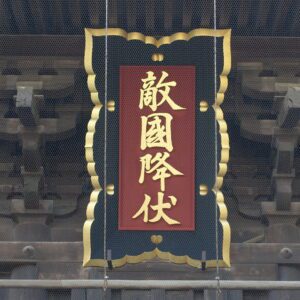

The Rōmon (tower gate) was built in 1594 by Takakage Kobayakawa. The Rōmon of Hakozaki Hachiman Shrine has the same atmosphere as the Rōmon of the Zen Buddhist temple, similar to the Rōmon of Kashiigu Shrine that I visited the day before.
The main hall / worship hall, the tower gate, the Ichi-no Torii (the Hakozaki-style of torii), and the stone lanterns of Sen no Rikyu are national important cultural properties. Ichi-no Torii was built in 1609 by the feudal lord Kuroda Nagamasa. The main shrine, worship hall, and Sen no Rikyu stone lanterns can only be seen from the edge of the tower gate.
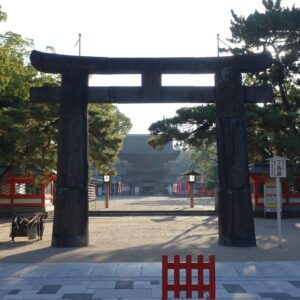

Tochoji is the first temple in Japan built by Kobo Daishi (Kukai). In the Great Buddha Hall on the 2nd floor, there is the Great Buddha of Fukuoka (height 10.8m), which is one of the largest wooden statues in Japan. However, I could not see the proper figure of the Great Buddha during the large-scale repair.
Rokkakudo was built in 1842. It is a cultural property of Fukuoka City.
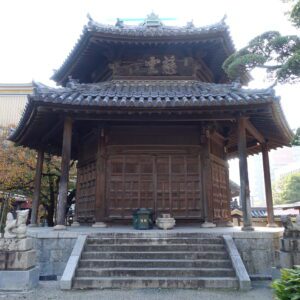

The five-storied pagoda was built in 2011. It is built by a traditional method that does not use nails.
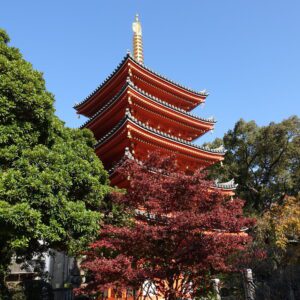

Hakata Gion Yamakasa (July) is dedicated at Kushida Shrine. The decorative Yamakasa is permanently installed. Hakata Okunchi is held in October. The Hakata Dontaku group in May also has a tradition of departing from Kushida Shrine. In other words, Kushida Shrine is involved in many of the nationally famous festivals in Fukuoka.


The Hakata Gion Yamakasa event is registered as a UNESCO Intangible Cultural Heritage, an important intangible cultural property of the country.
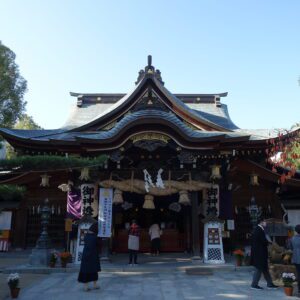

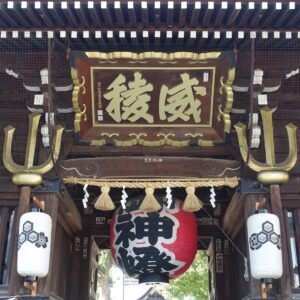

Nanzoin is the main temple of Sasaguri Shikoku Sacred Ground and is a special head temple of Koyasan Shingon sect. Sasaguri Shikoku is a sacred place in 88 places in Sasaguri-cho, Kasuya-gun, Fukuoka Prefecture. The most famous statue in Nanzoin is the reclining Buddha. It is one of the largest bronze products in the world (total length 41m).


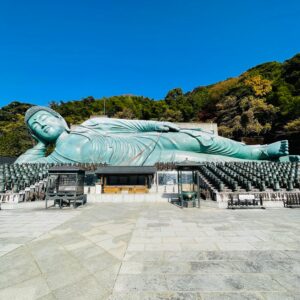

There are many Buddhist statues such as Fudo Myo and Bishamonten in the precincts of Nanzoin, and it is a fun precinct just to walk.


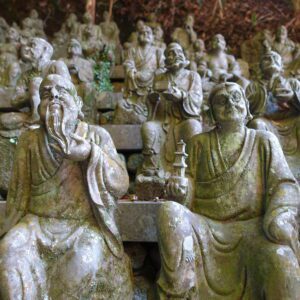

Jotenji Temple was founded in 1242 by Shoichi Kokushi. It is a temple of the Tofukuji sect of the Rinzai sect, which is a sect of Zen sect. There is a magnificent stone garden in front of the main hall.


Jotenji Temple is also the birthplace of numerous events and goods such as Hakata Gion Yamakasa, Udon, Soba, Manju, and Hakata Ori.
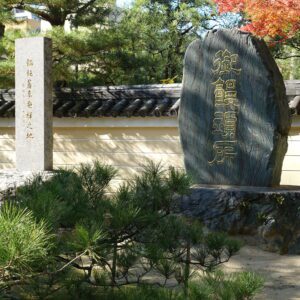

Myorakuji Temple, which is just a short walk from Jyotenji Temple, is a temple of the Rinzai sect Daitokuji sect, which is a sect of Zen sect. It was founded in 1316 by Gestudo Soki.


Originally, Myorakuji was located on the coast of Hakata Bay and played an important role in trade with the continent. Myorakuji is the birthplace of “Uiro”.


There was a magnificent Hakata-bei (Hakata wall) at Myorakuji. Hakata-bei began when Toyotomi Hideyoshi reconstructed the town of Hakata, which had been abandoned due to the war in the Warring States period, using burnt stones and roof tiles. I think it is also excellent in terms of design.
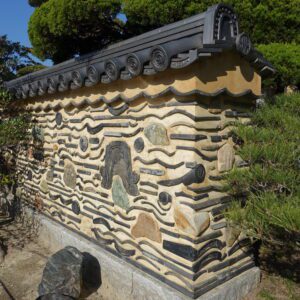

Shofukuji Temple is the first Zen temple in Japan (Rinzai sect Myoshinji school) founded by Yosai Zenji in 1195. The precincts are designated as a national historic site. The land of Shofukuji was donated by Minamoto no Yoritomo, the shogun of the Kamakura Shogunate.There is a long Hakata-bei between the main gate and the Chokushi-mon gate. It was the most wonderful Hakata-bei I saw in Hakata.


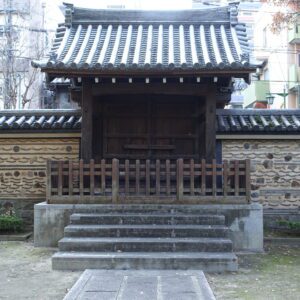

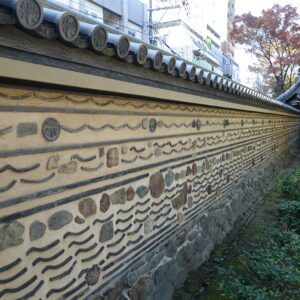

The gate was rebuilt in 1911. It is a magnificent mountain gate.


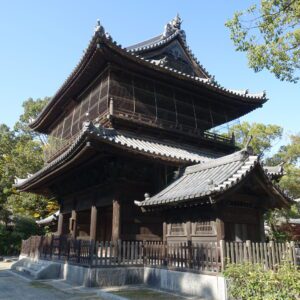

The Buddhist temple was expanded in 2014, so it is very beautiful. The past Buddha “Amitabha”, the modern Buddha “Shaka Nyorai”, and the future Buddha “Miroku Nyorai” have been newly built and enshrined.
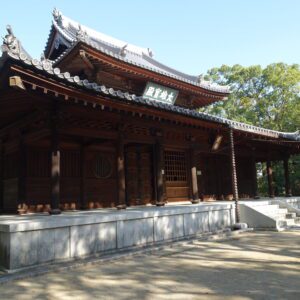

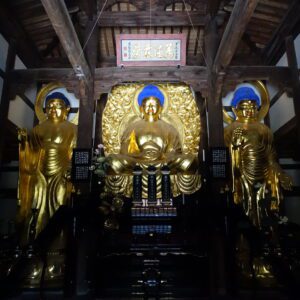

The precincts of Shofukuji Temple were so quiet that I couldn’t believe there was a temple in the middle of the big city of Hakata.
Sumiyoshi Shrine is a shrine that enshrines Sumiyoshi Sanjin, the guardian deity of voyage. The exact year of construction of Sumiyoshi Shrine is unknown, but it is said that the homepage of Sumiyoshi Shrine has a history of “more than 1800 years”. It is one of the “three major Sumiyoshi” along with Sumiyoshi Taisha in Osaka and Sumiyoshi Shrine in Shimonoseki.
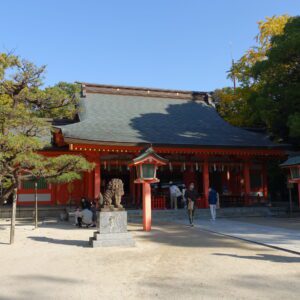

The main hall of shrine is a national important cultural property.
Meals
On the last day of my trip to Nagasaki and Fukuoka, I had Hakata Ramen for lunch early. The ramen shop that became the last ramen on the trip is “Nadai Ramen-tei” in the Hakata Station EKICHIKA (Underground Shopping Center). Moreover, the morning service was exceptionally cheap at Yen 480 (usually Yen 580) for char siu (barbecued pork) noodles. It’s cheap and delicious ramen. It is one of the best Hakata ramen I have ever eaten.


I had an early dinner at “Izakaya Maruya Nishinakasu“. “Izakaya Maruya Nishinakasu” is an izakaya with a focus on fish and shellfish. Especially, “squid sashimi (sashimi prepared from live squid, arranged in its original shape)
” is famous. Of course, I also ordered it. The squid of the day was oval squid. It was fresh, sweet and chewy, and it was very delicious.



After eating squid sashimi, the rest was made into tempura for free.
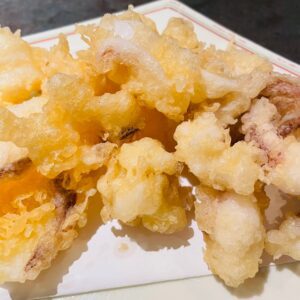

I also ordered pickled mackerel, cod milt, and sashimi of ark shell. Most of the food was delicious overall, and the service of the clerk was good, so “Izakaya Maruya Nishinakasu” was a very satisfying shop. It is a recommended izakaya when eating seafood in Hakata.
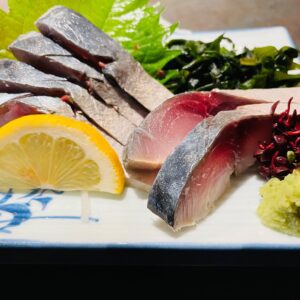



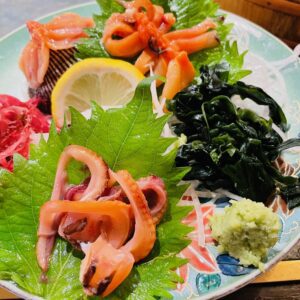

Before heading from Hakata Station to Fukuoka Airport, I went to “Izakaya Hikari”. I had dinner at “Izakaya Hikari” the day before. I visited in a row because all the meals were delicious when I visited the day before and I was attracted to the poster of “Kue (longtooth grouper) Nabe for one person”.
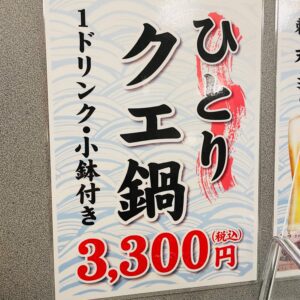

A hot pot of high-class fish Kue (also called Ara in Kyushu), one drink, and a small bowl of “Kue (longtooth grouper) Nabe for one person” for Yen 3,300 is a great deal. However, the problem was the offer time. It took about 50 minutes from ordering to serving “Kue Nabe”.
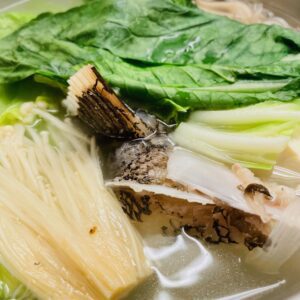

The taste of “Kue Nabe” was delicious. However, it is certain that “Hikari” was disappointed with the long offer time. When you go to “Hikari”, I think it’s best to order something other than hot pot dishes. Or, if you order hot pot dishes, order other dishes and wait patiently.
Important points
Please note that visiting Nanzoin is prohibited in clothes with a lot of exposed skin (hot pants, extreme miniskirts, camisoles, etc.). It’s winter now, so I think it’s okay, but be careful in the hot season. It seems that a cloth that can hide the exposure is rented at the shop in JR Kidonanzoin-mae station.
Note: The departure / arrival times, fares, admission fees, meal fees, etc. of the transportation facilities listed in the text are as of the time of writing the BLOG. They may change in the future, so please verify yourself when you go on a trip.
